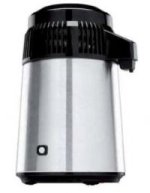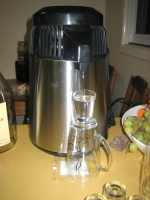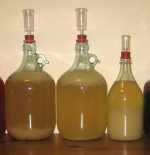
Alcohol from Colditz, revisited (3)
Note from ND:
WARNING: The article below mentions the distilling of alcohol. You are warned that private distillation of alcohol is illegal in many parts of the world, including the UK. DO NOT DO IT unless you have checked the regulations for your country. Extremely heavy fines are imposed by H.M.Customs and Excise, and this site does not condone illegal activity.
The experiment below is reported solely because of its historical interest and relevance to my article “Alcohol at Colditz”. I often receive emails asking how British soldiers made alcohol when locked up in the middle of nowhere. The experiment below answers some of the questions.
OK – back to D.H; I reproduce the article exactly as he sent it.
.......It's been an interesting week.
Jar 2 started bubbling the next day, Monday. The lumpy jam bits ended up floating, just like any good country wine primary fermentation. Jar 1 and Jar3 were apparently not doing anything.
By Tuesday night, Jar 2 was still fermenting well, but Jars 1 and 3 were looking very suspect.
Taste test 1 revealed that there was no vinegar in the jars, they just tasted like sugared water.
Jar 3 was much sweeter than jar 1. overall taste was ‘ok’, just an oversweet punch. The sort of thing that you would drink if it was given to you on a hot day, but would probably try to forget where you had put your glass down. The aftertaste of the jam was not evident.
Wednesday night
After all the hassles of making the Turnip jam, was unwilling to lose any of it.
Taste test 2, no change. Just sugared water, no vinegar.
I added some yeast starter to jar 1 and jar 3.
Thursday, I bought the Darlek.

This is a still made in New Zealand for producing distilled water and essential oils. If legal in your country, it can also be used to distill alcohol. It uses air rather than water for cooling, and is advertised as being really a pot still rather than a reflux still. (yes I did a lot of investigation, and fell in love with this still)
Thursday night
Ran some plain water through the animal to ensure that it was clean, then tipped in two 2litre flagons of ‘home brand’ port. Nothing wrong with it as a port that I paid $11 a 2litre flagon for, it is a good quaffing port.

The first tumbler
Learnt a lot about the smell and taste of the initial methanol output, the ‘good stuff’ at about 40%, and the tails with all sorts of unacceptable flavours.
Was expecting to have the initial flavour preserved/concentrated by the process, that’s what ‘pot stills’ are supposed to do. Would like to try a traditional pot still, but water requirements and general ease of use started me here. Maybe, some time in the future.
This little animal however produces a bland output.
It must be noted here that distilling alcohol is legally unacceptable in Australia; folk are only allowed to own distillation equipment for the production of distilled water and essential oils. Think it has something to do with the ‘rum rebellion’ during Australias early ‘white invasion’ history, can’t have people distilling their own currency. Amazing how inventive the colonial masters were. You will have to check the accuracy on that story for yourself, it’s a good story though, I like it:)
Since I was going away for the weekend, decided that if there was no action before I left, I’d add more of my starter bottle to them.
So Friday afternoon I added more yeast starter to jar 1 and jar 3.
Sunday night:

The photo above shows the Sunday night jar state.
Jar 1 is definitely fermenting now, lumpy bits floating and the fermentation lock shows plenty of action. The black bits are raisins not a strange infestation.
Jar 2 is still fermenting, slowed a little, but this may just result from a slightly lower temperature.
Jar 3 has started, but is very slow. It may be that there is two much sugar in it, didn’t measure the jam quantity.
Wanted to have some more liquid to run through the darlek, so had bought some of the recommended yeast (Classic Turbo ) at a brewers supply shop over the weekend.
Scaled the 21 liter quantities recommended to that required for a 4 ˝ liter jar.
The fermentation had started very well within ˝ hour of mixing. By the time I went to bed it was working better than any of the other jars.
Current State of play of the various gallons.

Left to right
Plum wine, slowing but still fermenting
Jar 1, fermenting
Jar 2, fermenting, slowed from initial
Jar 3, fermenting slowly
Back, Primary second use of elderberries and ginger beer plant with powdered ginger
Front, Marinating grapes in port, had a dodgy seal so am a bit concerned about it
Back, Secondary fermentation of the first pass elderberry
Front, Two small bottles containing darlek output
Back, Secondary fermentation of the mead
Middle, The hidden jar, trial of the recommended turbo yeast.
Front, The darlek, just another kitchen appliance
Not shown, two 2 liter jugs with a sugar/yeast mix. Didn’t expect me to throw out those two port flagons, did you?
Monday morning, the turbo yeast jug looks like a bottle of lemonade that has just had the lid taken off. The plum and mead ferments achieved about 2 bubbles in 3 seconds this is about 5 bubbles in 1 second. I’m tempted to send you a video of it. You could drive a steam turbine off a 21 liter batch of this stuff.
....continued